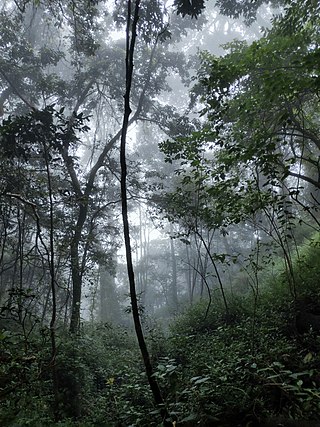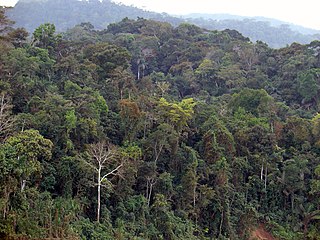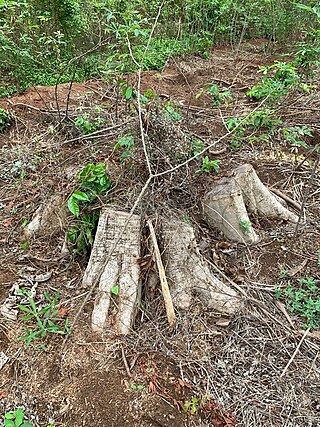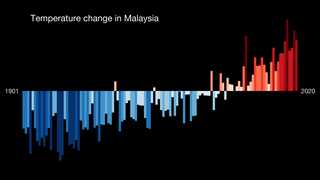This article includes a list of general references, but it lacks sufficient corresponding inline citations .(June 2014) |

Energy in Belize is based on four main sources: imported fossil fuels, biomass, hydro, and imported electricity.
This article includes a list of general references, but it lacks sufficient corresponding inline citations .(June 2014) |

Energy in Belize is based on four main sources: imported fossil fuels, biomass, hydro, and imported electricity.
Belize currently imports 100% of its fossil fuel use (Launchpad Consulting, 2003). Under the San Jose Pact, which Belize signed onto in 1988, Mexico and Venezuela signed a treaty obligating them to offer a concessionary credit from 20-25% of the purchase price of their oil exports. In 1991, both countries increased the oil supply offered under this agreement (Belize – Mining and Energy Industry, 1992). However, fuel prices had jumped to a record high in 2008, over $10 per gallon (Armageddon, 2008). [1]
Since 1981, extensive drilling has occurred throughout Belize to find oil deposits. Near Spanish Lookout and northwest of Belmopan, two oil fields were located. Drilling in these two fields began in 2005 and was predicted to reach a peak by 2010 (Belize, 2010). [2]
Sustainable energy is the main goal for Belize. In 2003, the Public Utilities Commission implemented a one-year project entitled Formulation for a National Energy Plan for Belize. The project, funded by the United Nations Development Fund, developed a comprehensive National Energy Policy to promote environmentally sound, safe, reliable, affordable energy (National Energy Plan, 2001). In 2011 this plan was updated with the Framework for the National Energy Policy. [3] The Ministry of Energy, Science & Technology, and Public Utilities was founded following recommendations from the framework.
Belize has also taken a role in reducing greenhouse gas emissions. The Belize and Nicaragua Logs Recovery project aims to reduce greenhouse gas emissions and prevent deforestation by salvaging mahogany and other logs in the Belize and Nicaragua Rivers (Legace and Legault International Inc., 2007).
Also, in compliance with the United Nations’ program REDD, Reduction of Emissions from Deforestation and forest Degradation, a national workshop performing with the Ministry of Natural Resources and Environment and the Forest Department of Belize are coordinating efforts to forest management and reduction of deforestation (Protecting Belize and other Central American Countries – Reducing Emissions: REDD, 2010). Along with signing the San Jose Pact, Belize has also been a participant to the Kyoto Protocol.

Resource depletion is the consumption of a resource faster than it can be replenished. Natural resources are commonly divided between renewable resources and non-renewable resources. Use of either of these forms of resources beyond their rate of replacement is considered to be resource depletion. The value of a resource is a direct result of its availability in nature and the cost of extracting the resource, the more a resource is depleted the more the value of the resource increases. There are several types of resource depletion, the most known being: Aquifer depletion, deforestation, mining for fossil fuels and minerals, pollution or contamination of resources, slash-and-burn agricultural practices, soil erosion, and overconsumption, excessive or unnecessary use of resources.

Carbon offsetting is a trading mechanism that allows entities such as governments, individuals, or businesses to compensate for (i.e. “offset”) their greenhouse gas emissions by supporting projects that reduce, avoid, or remove emissions elsewhere. In other words, carbon offsets focus on offsetting emissions through investments in emission reduction projects. When an entity invests in a carbon offsetting program, it receives carbon credits, i.e "tokens" used to account for net climate benefits from one entity to another. A carbon credit or offset credit can be bought or sold after certification by a government or independent certification body. One carbon offset or credit represents a reduction, avoidance or removal of one tonne of carbon dioxide or its carbon dioxide-equivalent (CO2e).
A public utilities commission is a quasi-governmental body that provides oversight and/or regulation of public utilities in a particular area, especially in the United States and Canada.

Sustainable forest management (SFM) is the management of forests according to the principles of sustainable development. Sustainable forest management must keep a balance between the three main pillars: ecological, economic and socio-cultural. The goal of sustainable forestry is to allow for a balance to be found between making use of trees while maintaining natural patterns of disturbance and regeneration. The forestry industry mitigates climate change by boosting carbon storage in growing trees and soils and improving the sustainable supply of renewable raw materials via sustainable forest management.

Peruvian Amazonia, informally known locally as the Peruvian jungle or just the jungle, is the area of the Amazon rainforest included within the country of Peru, from east of the Andes to the borders with Ecuador, Colombia, Brazil and Bolivia. This region comprises 60% of the country and is marked by a large degree of biodiversity. Peru has the second-largest portion of the Amazon rainforest after the Brazilian Amazon.
Germany is Europe's largest and the world's 6th greatest single emitter of CO2. In July 2007, Germany had the largest European population, with 82.4 million people. Germany imports most of its materials and energy sources, and in 2004 imported 2.135 million barrels of oil and 85.02 billion m³ (2003) of natural gas a day. In 2004, Germany emitted 886 million metric tonnes of CO2. In 2004, there were approximately 45 million registered cars in Germany.

Brazil once had the highest deforestation rate in the world and in 2005 still had the largest area of forest removed annually. Since 1970, over 700,000 square kilometres (270,000 sq mi) of the Amazon rainforest have been destroyed. In 2001, the Amazon was approximately 5,400,000 square kilometres (2,100,000 sq mi), which is only 87% of the Amazon's original size. According to official data, about 729,000 km² have already been deforested in the Amazon biome, which corresponds to 17% of the total. 300,000 km² have been deforested in the last 20 years.

Deforestation in Nigeria refers to the extensive and rapid clearing of forests within the borders of Nigeria. This environmental issue has significant impacts on both local and global scales.

Deforestation in Indonesia involves the long-term loss of forests and foliage across much of the country; it has had massive environmental and social impacts. Indonesia is home to some of the most biologically diverse forests in the world and ranks third in number of species behind Brazil and the Democratic Republic of Congo.

Avoided Deforestation Partners, or AD Partners, is a non-profit organization under the auspices of the Center for International Policy in Washington, D.C. AD Partners is involved in the global effort to solve climate change by working to end deforestation in tropical rainforest countries. By avoiding the practice of deforestation, i.e., clearing forests to provide inexpensive farmland, the world gains the significant climate benefits of not releasing carbon into the atmosphere. In addition, avoiding deforestation also allows forests to sequester carbon and scrub the air of pollutants. Beyond protecting the Earth's air quality, tropical forests facilitate conditions for rain, replenish water sources, provide habitats for myriad plant and animal species, and sustain the livelihoods of 1.6 billion people globally. Leading scientists and economists say that ending deforestation is the most cost effective and scalable method of reducing greenhouse gases. In fact, they believe that ending deforestation will cut the timeframe for solving the climate crisis in half.
Energy in Zimbabwe is a serious problem for the country. Extensive use of firewood leads to deforestation and the electricity production capacity is too low for the current level of consumption.

Energy in Singapore describes energy related issues in Singapore, which is a developed country located in Southeast Asia. Energy exports to others are about three times the primary energy supplied in the country itself. Additionally, oil imports in relation to the population demands of the country itself are concerningly high.

The Rimba Raya Biodiversity Reserve, nearly the size of Singapore, consists of 64,000 hectares of bio-diverse tropical peat swamp forest that contain as much as 1,000 plant and animal species per hectare and is one of the most highly endangered ecosystems on the planet. The project area and ongoing initiatives focus on environmental conservation, community outreach, and climate control. Rimba Raya is home to one of the few remaining relic populations of wild orangutans and is the largest privately funded orangutan reserve in the world. The area is also one of the world’s largest repositories of carbon. Rimba Raya is the world’s largest REDD+ project -Reduced Emissions from (Avoided) Deforestation and Degradation (REDD). The project developer, InfiniteEARTH, is an industry pioneer, delivering the world’s first REDD methodology in 2009.

Deforestation is a primary contributor to climate change, and climate change affects forests. Land use changes, especially in the form of deforestation, are the second largest anthropogenic source of atmospheric carbon dioxide emissions, after fossil fuel combustion. Greenhouse gases are emitted during combustion of forest biomass and decomposition of remaining plant material and soil carbon. Global models and national greenhouse gas inventories give similar results for deforestation emissions. As of 2019, deforestation is responsible for about 11% of global greenhouse gas emissions. Carbon emissions from tropical deforestation are accelerating. Growing forests are a carbon sink with additional potential to mitigate the effects of climate change. Some of the effects of climate change, such as more wildfires, insect outbreaks, invasive species, and storms are factors that increase deforestation.
The Trans-Amazonian Railway is a proposed transcontinental railway through the Amazon Basin in Brazil, Bolivia, and Peru. The project was conceived in 2013 and announced in 2015 by Chinese and Bolivian leaders as part of a larger plan to create a Chinese-funded transportation network to support Bolivian imports and exports. The 1,435 mmstandard gauge transcontinental railroad megaproject proposed to link the Atlantic and Pacific Oceans by cutting through the Amazon rainforest. It was estimated to cost $10 billion circa 2015 and $72 billion circa 2023, and may not be able to recoup costs. Its sister projects include the Nicaragua Canal and a Colombian railway. It was included in the Brazilian National Transportation Plan.
Central African Forest Initiative (CAFI) was launched during the 2015 United Nations General Assembly in New York as a collaborative partnership between a coalition of willing donors, six Central African partner countries, and Brazil as South-South partner.

Climate change is having a considerable impact in Malaysia. Increasing temperatures are likely to greatly increase the number of heatwaves occurring annually. Variations in precipitation may increase the frequency of droughts and floods in various local areas. Sea level rise may inundate some coastal areas. These impacts are expected to have numerous environmental and socioeconomic effects, exacerbating existing environmental issues and reinforcing inequality.

Due to its geographical and natural diversity, Indonesia is one of the countries most susceptible to the impacts of climate change. This is supported by the fact that Jakarta has been listed as the world's most vulnerable city, regarding climate change. It is also a major contributor as of the countries that has contributed most to greenhouse gas emissions due to its high rate of deforestation and reliance on coal power.

Environmental Foundation Limited (EFL) is a public interest litigation and environmental conservation organisation in Sri Lanka. Established in 1981, EFL seeks to protect and conserve the natural environment through litigation, advocacy, awareness and youth-engagement.
Nadine Therese Laporte has been a researcher and professor of forestry and remote sensing for over 30 years. She is adjunct research professor at Northern Arizona University. Prior to becoming a scientist at the Woods Hole Research Center, where she was director of the Africa program, she conducted postdoctoral research at the University of Maryland in College Park and NASA’s Goddard Space Flight Center in Greenbelt Maryland. Laporte's research contributed to tropical forest policies a part of REDD+ REDD+ is a policy mechanism to reduce carbon emissions by helping to protect tropical forests and lessen deforestation. She assisted the government of the Democratic Republic of the Congo to quantify forest carbon stocks and emissions reporting for REDD+ under the UN Framework Convention on Climate Change (UNFCCC). This method was suggested because it would help protect biodiversity, people living in the area, and maintaining stored carbon in these tropical ecosystems.